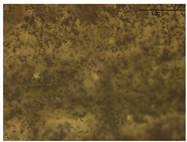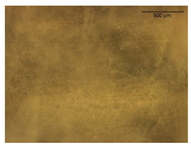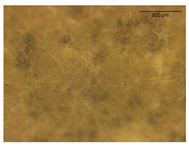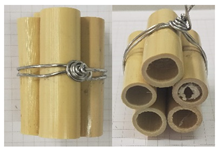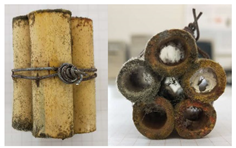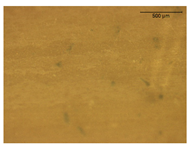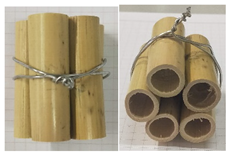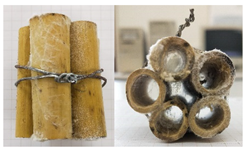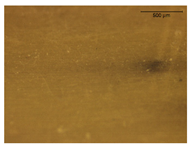Abstract
Bio-based and natural building materials can support the building sector to reduce its environmental impact. In this study, experimental research was developed to evaluate the performance of giant reed when used as a building thermal insulation. Reed was chosen due to its high availability and close relationship to Portuguese vernacular architecture. The role of the reed’s origin in this context, its physical characteristics and its durability aspects were evaluated. The results showed that the performance of the reed boards was compatible with their use as a thermal insulation material, regardless of the reed’s origin. Denser boards showed better results. Under the favourable conditions related to the reed’s water content, mould growth could occur.
1. Introduction
There is increasing energy use and greenhouse gas emissions related to the growing scale of human activities. The building and construction sectors contribute to over 1/3 of the global final energy use and nearly 40% of the total direct and indirect CO2 emissions []. The most significant part of the energy use of buildings is the operation phase, and it is predicted that the global energy demand for cooling will triple by 2050 []. Furthermore, the COVID-19 pandemic changed the building sector’s energy use profiles, increasing the energy use in residential buildings. For example, residential energy use in the United States increased by 6–8% in 2020 compared to 2019 []. Therefore, reducing buildings’ energy use is imperative.
Utilizing bio-based materials in the building industry holds good potential, as the carbon sequestered by plants can offset part of the carbon emissions produced from the building []. Concerning their thermal performance, some of these materials can have characteristics similar to industrially produced ones [] when used as thermal insulation materials but with a lower embodied energy []. This low embodied energy has benefits in terms of the life cycle performance of buildings.
Fast-growing bio-based materials have even more advantages. According to Pittau et al. [], fast-growing plants provide an opportunity to decrease the carbon footprint of buildings as they do not require long rotation periods. Not only do they improve insulation but using plants as exterior wall insulation also increases carbon storage []. One particularly promising option is reed, which is a fast-growing plant [].
1.1. Use of Reed in Portuguese Vernacular Buildings
Reed has been utilized for a variety of purposes for centuries [,]. Its versatile properties and abundance have made it a widely used building material throughout history, as evidenced in Portuguese vernacular architecture.
Arundo donax can be found throughout Portugal []. It has been used as thermal insulation for a long time in Portuguese vernacular architecture. It can be seen in roofs [], as shown in Figure 1a,b, and walls [] throughout the country, especially in the Alentejo and Algarve regions (south of Portugal). Techniques such as “encaniçado”, which consists of using rows of reed tied together and tied to the structural timber beams, allow the roof to achieve a better thermal performance []. The use of reeds on roofs is also related to aesthetic issues, such as in the “treasure roofs”, i.e., the complex roofs typically used in Tavira nobility buildings (16th century) [].

Figure 1.
(a,b) Use of reed for roof construction in Alentejo region (Portugal).
The insulation of the walls was also improved by using reed in the vernacular buildings. In the centre of Portugal, some of the “palheiros” (palafitic timber buildings) used reed inside the exterior walls []. Reed was also used in the frames of “tabique” walls (wood-framed walls finished with clay mortar), a technique that can be found almost everywhere in Portugal []. These examples of the use of the reed emphasise its important role in Portuguese vernacular architecture and its importance as an insulation material in this type of building.
1.2. Reed as a Thermal Insulation Material
Researchers around the globe have examined the potential of using reed as building thermal insulation [,,,]. Some studies have looked at the thermal capabilities of boards containing reed as a component of bio-based materials [], while others have focused on boards made entirely of natural reed []. Regardless of the form it takes, reed has been found to have a satisfactory thermal performance, with thermal conductivity values ranging from 0.045–0.056 W/m.K [].
Phragmites australis and Arundo donax are the most-documented species in current studies. Most research has studied the thermal performance of Phragmites australis instead of Arundo donax. This choice can be related to the reed availability in the region. However, it is important to note that these species present significant differences in terms of their physical characteristics. The diameter is around 10 to 25 mm for Phragmites australis [,] and 25 to 50 mm for Arundo donax [,].
Concerning the solutions achieved using only reed, Miljan et al. [] used reed (Phragmites australis) to construct an insulated test house and study the thermal properties of the walls. They found that the thermal transmittance of the walls ranged from 0.130 to 0.257 W/m2.K. Asdrubali et al. [] carried out a thermo-acoustic characterization of reed panels (Phragmites australis), which showed that the layout and characteristics of the reeds did not greatly affect the equivalent thermal conductivity, but they did affect the acoustic behaviour of the material. It is important to note that the conclusions of these studies may not apply to Arundo donax, as there are significant physical differences between the two reed species.
Carneiro et al. [] explored the use of reed, specifically Arundo donax (giant reed) harvested in Portugal, as a component in bio-based building materials. They constructed boards using giant reed stalks and fibers and used them in a prototype building. Temperature monitoring during different seasons revealed that the solution effectively controlled the indoor air temperature, despite fluctuating outdoor temperatures.
The above-mentioned studies highlighted the thermal insulation potential of reeds around the world, regardless of the specie. However, since plant growth and development are influenced by several environmental factors, such as temperature and humidity [,], it is also important to study the influence of the reed’s origin on its thermal performance. Furthermore, with reed being an organic material, it is susceptible to biological attack. It is important to consider its durability aspects and develop solutions that respond positively to contact with aggressive agents, with the aim of achieving minimum maintenance needs and life cycle costs. Some research has been developed in this scope, achieving satisfactory results when compared to conventional materials []. Despite this, this is an area of knowledge that is still a little unknown, with only a few papers dealing with this subject. For instance, Bergholm [] studied the external surface of Prhagmites australis from different regions of Finland and observed that the origin of the reed was not relevant in terms of its resistance to mould. However, the influence of the origin of the reed on thermal performance has not yet been studied.
Considering that the characteristics of natural materials can vary depending on their location [,], this paper contributed to the improvement in the knowledge of sustainable building materials by carrying out experimental research on Arundo donax harvested in different regions of Portugal. The inner and outer surface durability of the reed and the influence of the origin of the reed on the thermal performance were studied here, and these have not yet been recorded in other research works related to Arundo donax. Furthermore, the relationship between the density and thermal conductivity of the reed boards was also studied. The results of this research can help to provide an important shift in the boundaries of knowledge in the field, providing a more realistic approach and moving towards more sustainable buildings and heritage conservation.
2. Reed Harvest Sites
With Arundo donax being present in all regions of the country, and considering the differences in the Portuguese climate, three different sites were chosen for harvesting the giant reed (Figure 2).
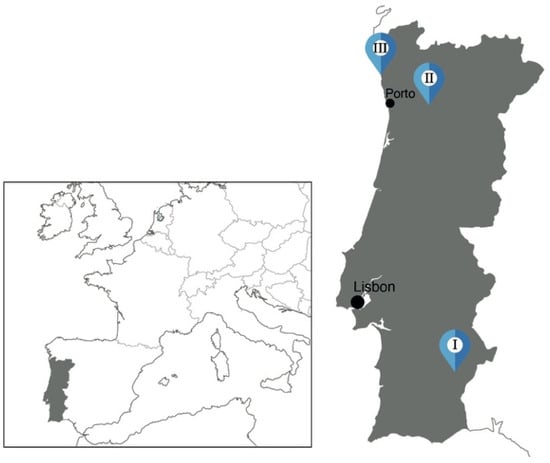
Figure 2.
Giant reed harvest regions: Serpa (Region I), Santa Cruz do Douro (Region II) and Apúlia (Region III).
Region I was Serpa, the driest and hottest region studied. This city in the south of Portugal is located 200 m above sea level [] and it is characterised by having a temperate climate according to the Köpp–Geiger Climate Classification, sub-type Csa (temperate with hot and dry summer) []. Region II was Santa Cruz do Douro. This parish in the north of Portugal is located at 400 m above sea level [] and is also characterised by having a temperate climate, sub-type Csa. However, the precipitation in Region II is usually higher than in Region I, and the annual temperature (minimum and maximum) is generally lower than in Region I (Table 1). Region III was Apúlia, the rainiest region studied. This village on the Northern coast of Portugal is located 10 m above sea level [] and it is characterised by having a temperate climate, sub-type Csb (temperate with dry or temperate summer) []. Table 1 summarises some climate data related to these regions.

Table 1.
Climate data for the giant reed harvesting sites [].
3. Experimental Campaign
Considering the use of giant reeds in thermal insulation boards, the experimental campaign was divided into three main steps. In the first step, the thermal performance of giant reeds from the different studied regions of Portugal (Regions I, II and III) was evaluated (Figure 2). The giant reeds from Region I were used to study the influence of the geometric parameters on the thermal performance of the giant reed. This region was chosen due to its close relationship with Portuguese vernacular architecture. Second, the physical behaviour of the giant reeds from Regions I, II and III was evaluated to analyse the water capillarity when in contact with water. Third, the biological behaviour of these giant reeds was also evaluated to understand the related mould growth.
3.1. Thermal Performance
3.1.1. Giant-Reed Board Development
The giant-reed boards were developed to evaluate the thermal performance of the giant reeds harvested in Portugal. The boards were made with the same length × height, 150 × 150 mm (Figure 3a), whilst varying only the thickness in order to evaluate its influence on the thermal properties studied. The giant-reed boards were made in three main steps: (1) cut the reed stalks in parts of 150 mm length; (2) prepare a steel wireframe using the pre-defined dimensions (Figure 3b); and (3) accommodate the giant reed stalks into the steel wireframe (Figure 3c).
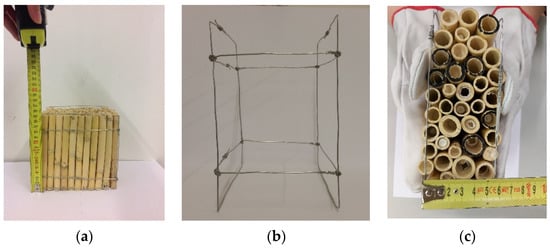
Figure 3.
Main steps for making the giant-reed boards used in the thermal evaluation: (a) giant-reed board; (b) steel wireframe; (c) accommodation of giant reeds into the frame.
Regarding the wireframe, it was made using steel wire (Φ 0.9 mm) only around the board’s borders to minimise its influence on the heat flux during the tests. Regarding the selection of giant reeds, this was made considering their regularity along their length. It is also important to note that the thickness was somewhat irregular, and this was related to the accommodation of the giant reeds into the wireframe.
To study the thermal performance of the giant reeds from different Portugal regions, one giant-reed board was made for each region studied. For this purpose, the samples were designed to have a similar density and, as a consequence, their thickness was not the same. Their identification and main characteristics are shown in Table 2. The identification was related to the region the reeds were obtained in and the boards' thicknesses. For instance, the giant-reed board II-50 was a board made using giant reed stalks from Region II, and it had a final thickness equal to 50 mm.

Table 2.
Identification and main characteristics of giant-reed boards from Regions I, II and III.
To study the influence of the geometric parameters on the thermal performance of the giant-reed boards, the giant reeds harvested in Region I were divided into two groups according to their diameter: small (S), 11–15 mm; and large (L), 15–22 mm. The boards were made using either only the giant reeds from group S, only those from group L or from a combination of S and L. The identification and main characteristics of the giant-reed boards used are shown in Table 3. The identification was related to the region, diameter and thickness. For instance, the giant-reed board I-L-100 was a board made using the giant reeds from Region I; it was large, and it had a final thickness equal to 100 mm. The giant-reed boards were tested in the vertical position, except for the boards I-S-100-H, I-SL-100-H and I-SL-150-H. “H” means a horizontal position.

Table 3.
Identification and main characteristics of giant-reed boards from Region I.
3.1.2. Thermal Characterisation of Giant-Reed Boards
A calibrated hotbox was used to assess the thermal properties of reed boards. It was designed and constructed in accordance with the ASTM C1363-11:2014 standard [], and it featured two chambers—one cold and one hot—separated by a 0.20 m thick mounting ring. The hotbox’s envelope was insulated with 0.20 m thick extruded polystyrene with a U-value of 0.21 W/(m2.K). Cold air entered the cold chamber through ventilation grids on the back wall, while hot air exited through the same grids, ensuring uniform heat flux conditions. The hot chamber included a heating system that helped to maintain a specific temperature (Figure 4a).
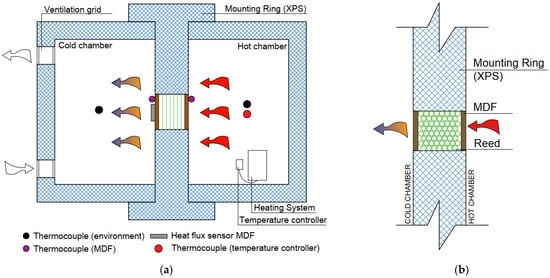
Figure 4.
Hotbox components and setup used for giant-reed board tests: (a) hotbox horizontal view; (b) mounting ring vertical view.
To accommodate the irregular surface of the giant-reed boards, medium-density fiberboard (MDF) panels were employed as a flat surface for the installation of a heat flux sensor (Figure 4b). The giant-reed boards were situated between the two MDF panels, and their edges were sealed to avoid air infiltration. The heat flux sensor (HFP01SC–Huskseflux/sensing area 8 × 10−4 m2) was located in the centre of the MDF. The thermocouples were installed in the cold and hot chambers according to the Figure 4a.
The tests were carried out based on ASTM C1155-95 []. The thermal resistance of the set (MDF + giant-reed board + MDF), ReSET (m2.K/W) and ReREED_BOARD (m2.K/W) were calculated (Equations (1) and (2)). The thermal conductivity of the giant-reed boards, λREED_BOARD (W/m.K), was also calculated (Equation (3)).
- q—heat flow through the set (W/m2),
- ΔT—difference between the MDF surface temperature in the hot and cold chambers (K),
- e—thickness of the giant-reed board (m).
According to ASTM C1155-95 [], for test convergence, a convergence factor (CRn) lower than 0.10 is required. Furthermore, to use the mean of Re to calculate the thermal resistance (Re), it is necessary that V(Re) < 10%, where V is the variance. Equations (4) and (5) represent the convergence factor and variance, respectively.
where t is the time in hours, n is the test for the convergence value and s(Re) is the standard deviation of Re based on N−1 degrees of freedom.
3.2. Physical Behaviour
Considering the hygroscopicity of the giant reeds, the water content and water capillary absorption were determined for the reeds from the different regions studied using adapted procedures. Only the giant reed stalks without nodes were evaluated. Considering the high variability of natural materials, five samples (5 cm length stalk) from each region studied (I, II and III) were used.
The water content (H) test consisted of drying the samples in an oven (376.15 ± 2 K) until reaching a constant mass. The water content was calculated as the difference between the wet mass, m0 (g), and the dry mass, m1 (g), divided by the dry mass, according to Equation (6).
The water absorption capillary test was carried out according to the procedure detailed in the study by Malheiro et al. []. The test consisted of determining the mass of water absorbed by the giant reed over a period of time. The mass absorbed was measured after 15, 30, 60, 120, 180, 240 and 360 min, and after every 24 h until the samples reached the saturated stage.
3.3. Biological Behaviour
Concerning natural materials, it is very relevant to know their biological qualities. Since the presence of mould was detected in previous research [], the performance of the giant reed against mould growth was studied. The giant reeds from the different regions studied were evaluated. Two types of samples were used: individual giant reeds and grouped giant reeds. In both cases, the samples were 50 mm in length. The individual samples were cut transversely in order to study the inner part of the giant reeds. In the grouped case, five reeds were joined as bundles (using the same steel wire used in the boards) to study the surface of the giant reeds and the effect of the interaction between them. Gloves were used during the sample preparation process to prevent contamination.
In the first step of the test, individual and grouped giant reeds from the different regions studied were evaluated. In the second step, only individual giant reeds from Region I were evaluated and compared to conventional insulation materials, namely extruded polystyrene (XPS) and rock wool.
The samples were evaluated visually, placed in a climatic chamber (ARALAB FitoClima 1000EC45), set to 295.15 ± 2 K and 90 ± 5% HR and checked weekly for five weeks. Both bare-eye and microscope methods were used for the visual analysis, with the microscope being a bright-field (DM750 M, Leica) microscope paired with a high-definition digital camera (MC170 HD, Leica) and the Leica Application Suite (version 4.12.0). Mould growth was quantified using the mould index method (Table 4) and a visual inspection was independently carried out by two people to minimize the error.

Table 4.
Mould indexing classifications (adapted from []).
4. Results and Discussion
4.1. Thermal Characterisation
4.1.1. Characterisation of Giant Reeds from Different Portuguese Regions
The main results from the hotbox test are shown in Figure 5, Figure 6 and Figure 7. These graphs show the surface temperatures and heat flux reached during the 72 h test (multiples of 24 h []) for the giant-reed boards shown in Table 2.
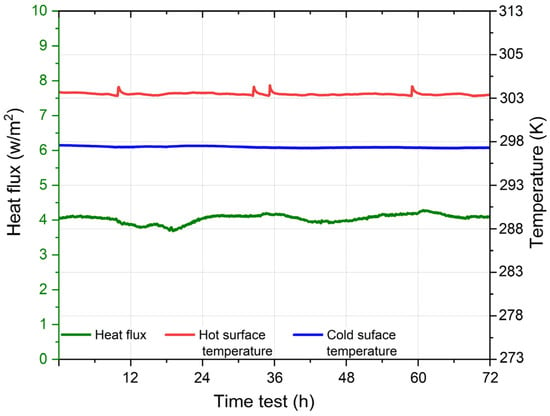
Figure 5.
Hotbox test results for giant-reed board I-55.
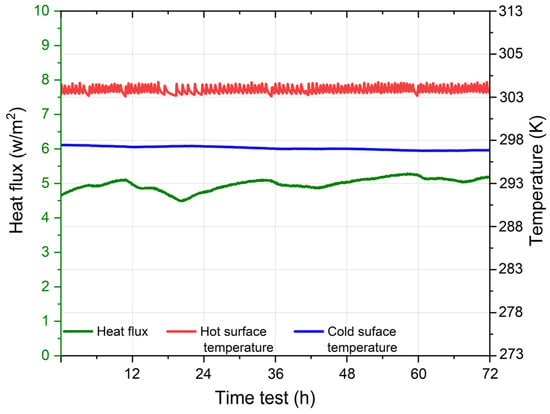
Figure 6.
Hotbox test results for giant-reed board II-50.
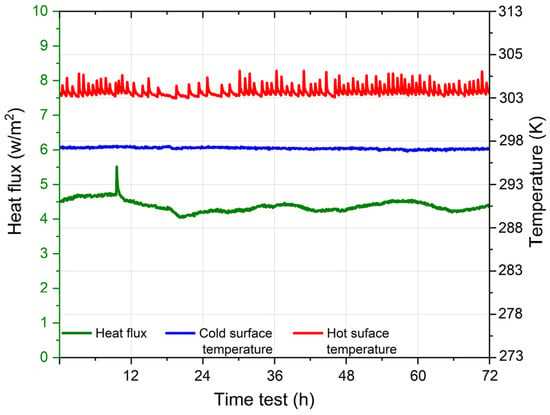
Figure 7.
Hotbox test results for giant-reed board III-50.
Figure 5, Figure 6 and Figure 7 show a trend toward a stable heat flux and surface temperatures during the entire test. The cold surface temperature remained very stable regardless of the board studied. Concerning the hot surface temperature, it was possible to verify slight perturbations during the test period, these being more evident in the results for the boards II-50 and III-50. Despite this, the difference between the temperatures of the hot and cold surfaces remained above 6 degrees, regardless of the board studied. These slight perturbations did not influence the thermal parameters calculated (Table 5), since all the data shown in Figure 5, Figure 6 and Figure 7 converged according to Equations (4) and (5). Table 5 summarises the average values obtained from the hotbox tests and shows the thermal parameters calculated using Equations (1) to (3). The MDF panels were individually tested in the hotbox, and they had a thermal resistance (ReMDF) equal to 0.147 (m2.K/W).

Table 5.
Average values of the studied thermal parameters: giant-reed boards from Regions I, II and III.
From the values shown in Table 5, it was evident that the boards studied showed a satisfactory thermal performance regardless of the region where the giant reed was harvested. The giant-reed board III-50 had the highest thermal resistance and, thus, a lower thermal conductivity when compared to the other boards studied. The giant-reed boards I-55 and II-50 showed very similar values for thermal resistance and conductivity.
4.1.2. Influence of Board Thickness and Giant Reed Diameter on the Thermal Parameters
Considering the satisfactory thermal behaviour shown for the giant reeds regardless of the region of Portugal that they were harvested in (Table 5), in this part of the study only the giant reeds from Region I were used. This choice was related to the relevant use of giant reeds in the vernacular architecture of Region I.
As in the previous section, all the giant-reed boards studied showed a trend of stable behaviour during the 72 h test, and their data converged according to []. Table 6 summarises the average values obtained from the hotbox test and shows the thermal parameters calculated using Equations (1) to (3). To better understand the influence of the board thickness and the giant reed diameter on the thermal parameters, Figure 8 relates these parameters with the reed board density.

Table 6.
Average values of the studied thermal parameters: giant-reed boards from Region I.
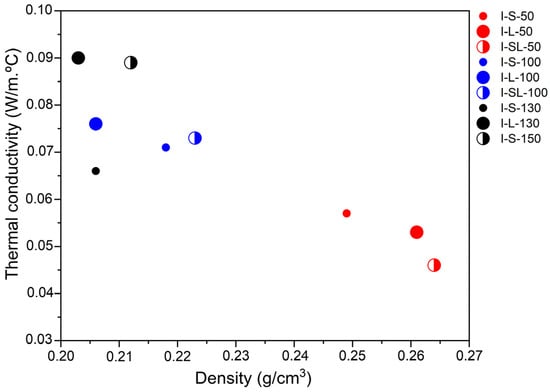
Figure 8.
Influence of board thickness and density and diameter of the reeds on the thermal conductivity.
Table 6 shows a trend of increasing thermal conductivity when the thickness of the giant-reed board increased. This increase in thermal conductivity was probably related to the density of the studied giant-reed boards. The studied boards with a 50 mm thickness were denser than others with different thicknesses (100, 130 and 150 mm). Analysing Figure 8, a trend of increasing thermal conductivity was observed when the density of the reed boards decreased. This happened because the lower the density, the higher the volume of voids between the giant reeds and, therefore, the higher the possibility of heat transfer by convection between the two sides of the giant-reed board. This behaviour was also verified by Asdruballi et al. []. They studied Phragmites australis samples using the hotbox and hot plate measurement techniques, confirming an increasing trend in terms of the thermal conductivity when the density decreased. In this sense, although all the studied reed boards showed satisfactory thermal performance, the boards with a higher density tended to present a better performance.
Concerning the diameter of the giant reeds used to make the boards, there was not a clear trend related to the thermal performance. Considering the board production process, the best thermal performance seemed to be related to the best accommodation of the giant reed, which achieved a higher density and fewer voids between the giant reeds. It is important to say that the accommodation of the giant reed was not only related to the diameter distribution but also to the regularity of the giant reed stalks. Most giant reed stalks have irregularities in their length, which makes it difficult to achieve a perfect fit between the stalks. Some of these irregularities are shown in Figure 9: (1) diameter reduction followed by a diameter increase; (2) ramifications; and (3) low horizontality. Figure 9 shows giant reed stalks of 1000 mm in length, but the irregularities shown were also relevant in the other boards (150 mm). Considering their diameters, it is likely that the problem of accommodation between stalks is more relevant for Arundo donax giant reeds than those of Phragmites australis.
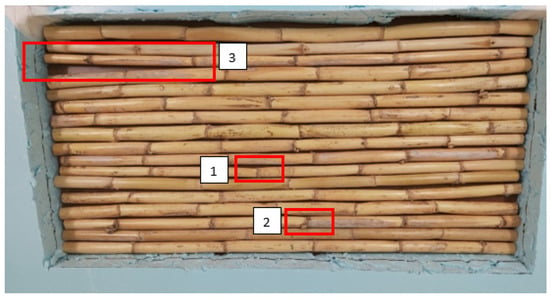
Figure 9.
Irregularities from giant reed stalks.
4.1.3. Influence of the Position of the Giant Reed Stalks on the Thermal Performance
To evaluate the influence of the position of the reed stalks (horizontal or vertical) on the thermal performance of the boards, the hotbox test was carried out in two ways: boards with giant reeds in the vertical direction (V), as shown in Figure 10a, and boards with giant reeds in the horizontal direction (H), as shown in Figure 10b. However, considering the influence of the density on the thermal performance verified in Figure 8, it only made sense to compare the reed boards with the same (or very close) density, as shown in Table 7.
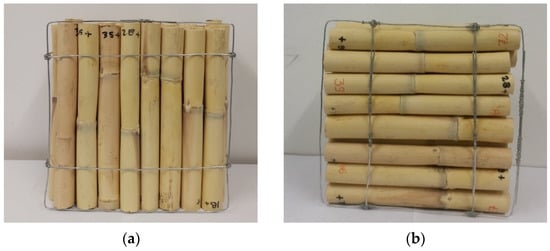
Figure 10.
Boards with giant reeds in different directions: (a) vertical direction; (b) horizontal direction.

Table 7.
Average values of the studied thermal parameters considering different directions during the hotbox test.
Although satisfactory results were reached by all the boards studied regardless of the stalks’ direction, the results from Table 7 show a very slight trend toward a better thermal performance of the giant-reed boards when the giant reeds were in the horizontal position. Horizontally, the giant reeds were better accommodated with a lower volume of voids between them through which air could circulate, therefore presenting a lower thermal conductivity.
According to the study carried out by Miljan et al. [] using Phragmites australis as the thermal insulation material, the boards tested in the horizontal direction achieved more expressive results (better thermal performance) when compared to the boards tested in the vertical direction. According to Miljan et al. [], the laying of reed insulation vertically is a complicated procedure (technically) and may provide more vertical voids between the reed stalks, thus facilitating convective air movement inside the board and, thus, a higher heat transfer. Miljan et al. [] built a test house insulated with reeds using only reed stalks. The difficulty in making these types of boards is probably reduced when using smaller reeds such as the ones used in the present study (150 mm length). Thus, the difference in the thermal performance when comparing the boards tested in the vertical and horizontal positions was also reduced, as verified in Table 7.
4.2. Physical Characterisation
Since water plays an important role in the behaviour of natural materials, the water content and the water capillary absorption of the giant reeds from the different regions studied were determined. The results of the water content test are presented in Table 8. Figure 11 shows the water capillary absorption during the test period. The values shown (table and figure) correspond to the average and standard deviation (SD) reached in five samples (5 cm length stalk).

Table 8.
Water content of giant reeds from different Portuguese regions.
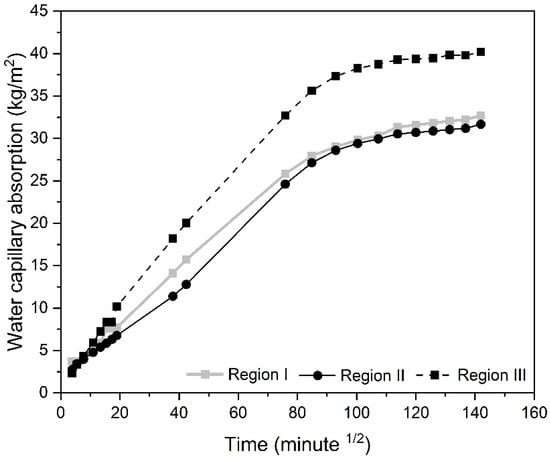
Figure 11.
Water capillary absorption of giant reeds from different regions as a function of the square root of test time.
Table 8 shows the similar water content values in the three samples analysed. However, it was possible to draw some relations between the water content of the giant reeds and the climatic conditions of the regions where they were harvested. It is known that plant growth and development are influenced by several environmental factors, including temperature and humidity [,]. From Table 8, it can be observed that the giant reeds from the rainiest region (Region III) showed the highest water content, while the giant reeds from the hottest region (Region I) showed the lowest value. This conclusion was corroborated by the water capillary absorption behaviour (Figure 11), which showed the fastest water absorption for the giant reeds with the highest water content (Region III). These giant reeds showed a faster water absorption than the giant reeds from Regions I and II during the whole test time. Furthermore, they reached the stabilisation level with the highest values, which means that they could accumulate more water than other reeds studied.
4.3. Biological Behaviour
Figure 12 shows the mould index evolution for the individual and grouped samples. For the grouped samples, the mould index corresponded to the external surface observation (excluding the tops of the reed stalks). In this sense, it was possible to compare the internal and external surfaces’ responses to mould growth. Table 9 shows the main results from the visual analyses (bare eyes and microscope) carried out during the test. The conventional materials studied, XPS and rock wool, did not show signs of mould growth during the entire test period and therefore are not represented in the figure and table below.

Figure 12.
Mould index as a function of the time for individual and grouped giant reeds.

Table 9.
Mould growth during the test period.
From the analysis of Figure 12 and Table 9 it is possible to conclude that under the specific conditions, mould grew in all the giant reeds studied regardless of the region and surface. Despite this, none of the giant reeds reached the maximum mould index (6) during the test period. The internal surface of the giant reeds showed a worse response to mould growth than the external one. According to Couvreur and Remón [], the external surface of reed has a layer of wax and a molecule, cutin, which gives the stalk a reduced permeability. This was probably the reason for its good response to mould growth. Although the tops were not evaluated weekly, when analysing the images in Table 9, the tops of reeds appeared to be a critical point for mould development.
Concerning the influence of the harvest region, it was possible to conclude that every sample had a similar behaviour in terms of mould development, regardless of its origin. These results were in accordance with the research carried out by Bergholm []. The author studied the external surface of Prhagmites australis from different regions and observed that the origin of the reed was not relevant to its resistance to mould.
The giant reeds from Regions I and II showed very close behaviour, reaching a mould index of 1.5 for the external surface and a mould index of around 4 for the internal surface at the end of the test. The giant reeds from Region III showed a slightly worst response to mould growth on both surfaces. This fact may be related to the higher water content of this reed when compared to the others (Table 8). The importance of the water content of giant reeds in terms of their response to mould growth has already been reported by Malheiro et al. []. These authors studied reeds dried in an oven (low water content) and giant reeds dried in a laboratory environment (water content 9.4%), and the drier reeds achieved a better response to mould growth.
5. Discussion: Giant-Reed Board as Insulation Material
Regarding the origin of the giant reeds used to make the boards (Figure 3), although the giant-reed board III-50, which was made with giant reeds from the rainiest region (Region III), achieved the best thermal performance (Table 5), the climate conditions seemed to have no significant influence on the boards’ thermal performance. The results presented in Section 4.1 showed a satisfactory thermal performance for all the giant-reed boards studied regardless of the Portuguese region from where the giant reeds were harvested. The behaviour of board III-50 may be related to its density since it had the highest density. As observed in Figure 8, there was a trend of better thermal performance when the density of the giant-reed boards increased.
The influence of the diameter of the giant reeds used to make the giant-reed boards was also evaluated, and no influence was verified. The giant-reed boards achieved a satisfactory thermal performance for the different compositions studied (i.e., using only giant reeds with small diameters, only giant reeds with large diameters and a combination of them (small and large)). The position (horizontal or vertical) of the giant reeds on the board during the hotbox test showed a trend to reach a better thermal performance when the giant reeds were placed in a horizontal instead of a vertical position. However, in this case, the dimensions of the giant-reed boards may have positively influenced it since it is easier to achieve a better accommodation of the giant reeds on a small board than on a large board. Analysing the thermal resistances and thermal conductivities reached and the difficulties in the experimental work performed (related to the irregularities of giant reeds), the accommodation of the giant reeds in the boards seemed to be crucial to reaching a high density of the boards and, consequently, a better thermal performance.
The values achieved for the thermal conductivity of the giant-reed boards with a density greater than 0.230 g/cm3 (boards of around a 50 mm thickness) were in accordance with the values presented in the literature, i.e., 0.045–0.056 W/m.K []. Concerning the insulation of the boards made only using giant reeds, the thermal conductivities achieved in this study were lower than those achieved by Asdrubali et al. [] using the hotbox test method; 0.065 W/m.K. The board developed by Asdrubali et al. [] had a similar thickness, 56 mm, a lower density, around 0.090 g/cm3, and a different reed species, Phragmites australis (common reed). The difference in the density was probably related to the reed species used and, consequently, the number of reeds used and the accommodation between them. The average diameter of Phragmites australis and Arundo donax differs significantly, with one measuring 10–25 mm and other measuring 25–50 mm []. Thus, it is important to exercise caution when comparing the results from different studies.
Considering the Portuguese thermal regulation, the thermal resistance and thermal conductivity values achieved by the studied giant-reed boards (density greater than 0.230 g/cm3) were in accordance with the requirements defined for thermal insulation materials, that is, Re > 0.30 (m2.K)/W and λ < 0.065 W/m.K []. Furthermore, when comparing these giant-reed boards with some conventional insulation products, a similar performance was observed (Table 10) when considering the similar thickness. In these cases, the thermal resistance of the giant-reed board represented at least 60% of the thermal resistance of rock wool and 76% of the thermal resistance of cork, for instance.

Table 10.
Comparison between the thermal characteristics of the giant-reed boards and the ones of conventional thermal insulation products.
The giant-reed boards studied had a higher density than conventional insulation materials (Table 10). It was 13 times denser than EPS and 2.4 times denser than cork. Furthermore, they could be also denser than reed boards made using Phragmites australis. Comparing the similar conditions (56 mm thickness []), the board studied were almost three times denser than boards made using Phragmites australis. Thus, it is important to take the density into account when designing the structure of the building element where it this material is going to be attached.
6. Conclusions
Due to its high energy use and greenhouse gas emissions, the construction industry has sought solutions to reduce its ecological footprint. Considering the weight of the energy used by air conditioning systems in the total building energy demand, this research contributed to its reduction through the development of an alternative insulation product with a lower potential environmental impact. Giant reed (Arundo donax) was the material chosen to develop the new insulation product due to its sustainability and high availability and because it is an invasive species in the Portuguese context.
Experimental research was carried out to evaluate the potential of using giant-reed boards as thermal insulation solutions. The influence of the origin of the giant reed on its thermal performance was evaluated. Some physical characteristics and durability aspects related to mould growth were also studied.
According to the results, the giant-reed boards had the potential to be used as thermal insulation solutions, regardless of the place that it was harvested from. The samples studied showed satisfactory thermal performance, since they reached thermal resistances (0.878–1.965 m2.K/W) and thermal conductivities (0.041–0.09 W/m.K) within the thresholds established by the Portuguese regulations for thermal insulation products. Furthermore, when comparing the giant-reed boards with some conventional insulation materials, a similar performance was observed. However, it is important to highlight the higher density of the giant-reed boards. A vapour condensation evaluation also needs to be studied together with coating materials (to control vapour permeability).
Concerning durability aspects, under the specific conditions (295.15 ± 2 K and 90 ± 5% HR), all the giant reeds studied showed a tendency toward mould growth. Nevertheless, these specific temperatures and humidities are uncommon in the Portuguese climatic conditions. There was a trend toward higher mould growth in the giant reeds with a higher water content. The higher water content was verified in the giant reeds from the rainiest region (Region III). A rigorous drying process before the production of giant-reed boards could be important for extending their durability. In addition, some treatments (natural or artificial) specific to wood or bamboo could also be applied.
In addition to the advantages in terms of thermal insulation, reeds have other ecological benefits. They are considered to be a carbon dioxide sink material and have the advantage of being biodegradable and low-cost. In this sense, the use of giant reed as a thermal insulation material will help in the design of a more sustainable built environment.
Author Contributions
R.M. (Raphaele Malheiro), A.M. and A.A. undertook the main part of the research that was the base of this paper. They developed the research method and analysed the results with the contribution of J.F. R.M. (Raphaele Malheiro) wrote the document with the input of S.M.S. and R.M. (Ricardo Mateus). S.M.S. and R.M. (Ricardo Mateus) helped to develop the discussion sections of the paper and provided critical judgment on the undertaken research. Additionally, they supervised all the work and revised the document. A.C. helped with the physical tests and M.T.A. helped in the durability tests (development and data analysis). All authors have read and agreed to the published version of the manuscript.
Funding
The authors would like to acknowledge the support granted by the FEDER funds through the Competitively and Internationalization Operational Programme (POCI) and by national funds through FCT (the Foundation for Science and Technology) within the scope of the project with the reference POCI-01-0145-FEDER-029328, reVer+.
Data Availability Statement
All experimental measurements are available upon request from the corresponding author.
Conflicts of Interest
The authors declare no conflict of interest. The funders had no role in the design of the study; in the collection, analyses, or interpretation of data; in the writing of the manuscript; or in the decision to publish the results.
References
- Topics Buildings—International Energy Agency. Available online: https://www.iea.org/topics/buildings (accessed on 2 March 2021).
- The Future of Cooling—Analysis—IEA. Available online: https://www.iea.org/reports/the-future-of-cooling (accessed on 8 June 2021).
- IEA. The Covid-19 Crisis and Clean Energy Progress—Analysis—IEA. Available online: https://www.iea.org/reports/the-covid-19-crisis-and-clean-energy-progress (accessed on 3 June 2021).
- Göswein, V.; Reichmann, J.; Habert, G.; Pittau, F. Land Availability in Europe for a Radical Shift toward Bio-Based Construction. Sustain. Cities Soc. 2021, 70, 102929. [Google Scholar] [CrossRef]
- Asdrubali, F.; D’Alessandro, F.; Schiavoni, S. A Review of Unconventional Sustainable Building Insulation Materials. Sustain. Mater. Technol. 2015, 4, 1–17. [Google Scholar] [CrossRef]
- Palumbo, M.; Lacasta, A.M.; Giraldo, M.P.; Haurie, L.; Correal, E. Bio-Based Insulation Materials and Their Hygrothermal Performance in a Building Envelope System (ETICS). Energy Build. 2018, 174, 147–155. [Google Scholar] [CrossRef]
- Pittau, F.; Krause, F.; Lumia, G.; Habert, G. Fast-Growing Bio-Based Materials as an Opportunity for Storing Carbon in Exterior Walls. Build Environ. 2018, 129, 117–129. [Google Scholar] [CrossRef]
- Haworth, M.; Marino, G.; Cosentino, S.L.; Brunetti, C.; De Carlo, A.; Avola, G.; Riggi, E.; Loreto, F.; Centritto, M. Increased Free Abscisic Acid during Drought Enhances Stomatal Sensitivity and Modifies Stomatal Behaviour in Fast Growing Giant Reed (Arundo donax L.). Environ. Exp. Bot. 2018, 147, 116–124. [Google Scholar] [CrossRef]
- Köbbing, J.F.; Thevs, N.; Zerbe, S. The Utilisation of Reed (Phragmites Australis): A Review. Int. Mire Conserv. Group Int. Peat Soc. 2013, 13, 1–14. [Google Scholar]
- Barreca, F. Use of Giant Reed Arundo donax L. in Rural Constructions. Agric. Eng. Int. CIGR J. 2012, 14, 46–52. [Google Scholar]
- Clamote, F.; Carapeto, A.; Pereira, E.; Holyoak, D.; Almeida, J.; Araújo, P.; Lourenço, J.M.P. Arundo_donax. Available online: http://www.flora-on.pt/#wArundo+donax (accessed on 16 April 2019).
- AAVV. Arquitectura Popular Em Portugal; Associação dos Arquitetos Portugueses: Lisboa, Portugal, 1988. [Google Scholar]
- Fernandes, J.; Malheiro, R.; De Fátima Castro, M.; Gervásio, H.; Silva, S.M.; Mateus, R. Thermal Performance and Comfort Condition Analysis in a Vernacular Building with a Glazed Balcony. Energies 2020, 13, 624. [Google Scholar] [CrossRef]
- Fernandes, J. O Contributo Da Arquitectura Vernacular Portuguesa Para a Sustentabilidade Dos Edifícios; University of Minho: Guimarães, Portugal, 2012. [Google Scholar]
- Santos, A. Telhados de Tesouro de Tavira—Modelos e Tipologias de Casas Nobres Da Ribeira Com Telhados Múltiplos. In Proceedings of the Colóquio Internacional Arquitectura Popular, Tradição e Vanguarda; ISCTE-IUL: Lisbon, Portugal, 2016; ISBN 978-989-732-985-2. [Google Scholar]
- Ferreira, D.M.; Araújo, A.; Fonseca, E.M.M.; Piloto, P.A.G.; Pinto, J. Behaviour of Non-Loadbearing Tabique Wall Subjected to Fire—Experimental and Numerical Analysis. J. Build. Eng. 2017, 9, 164–176. [Google Scholar] [CrossRef]
- Asdrubali, F.; Bianchi, F.; Cotana, F.; D’Alessandro, F.; Pertosa, M.; Pisello, A.L.; Schiavoni, S. Experimental Thermo-Acoustic Characterization of Innovative Common Reed Bio-Based Panels for Building Envelope. Build. Environ. 2016, 102, 217–229. [Google Scholar] [CrossRef]
- Barreca, F.; Martinez Gabarron, A.; Flores Yepes, J.A.; Pastor Pérez, J.J. Innovative Use of Giant Reed and Cork Residues for Panels of Buildings in Mediterranean Area. Resour. Conserv. Recycl. 2019, 140, 259–266. [Google Scholar] [CrossRef]
- Miljan, M.; Miljan, M.; Miljan, J.; Akermann, K.; Karja, K. Thermal Transmittance of Reed-Insulated Walls in a Purpose-Built Test House. Mires Peat 2014, 13, 1–12. [Google Scholar]
- Costa, A.; Almeida, M.; Santos, M.; Costa, M.; Ribeiro, V. Materiais, Sistemas e Técnicas de Construção Tradicional—Contributo Para o Estudo d Arquitetura Vernácula Da Região Oriental Da Serra Do Caldeirão; Edições Afrontamento e CCDR Algarve: Porto, Portugal, 2007. [Google Scholar]
- Stein, B.A.; Kutner, L.S.; Adams, J.S. Arundo Donax vs. Phragmites Australis. Available online: http://desertfishes.org/cuatroc/organisms/arundo-vs-phragmites.html (accessed on 24 March 2021).
- Speck, O.; Spatz, H. Mechanical Properties of the Rhizome of Arundo donax L. Plant Biol. 2003, 5, 661–669. [Google Scholar] [CrossRef]
- Carneiro, P.; Jerónimo, A.; Faria, P. Reed-Cob: Tecnologia Inovadora de Baixo Carbono Para Construção de Pequeno Porte. In Proceedings of the II Encontro Nacional Sobre Reabilitação Urbana e Sustentabilidade; iiSBE Portugal & Universidade do Minho: Lisboa, Portugal, 2017. [Google Scholar]
- Hatfield, J.L.; Prueger, J.H. Temperature Extremes_Effect on Plant Growth and Development. Weather Clim. Extrem. 2015, 10, 4–10. [Google Scholar] [CrossRef]
- Hirai, G.-I.; Okumura, T.; Takeuchi, S.; Tanaka, O.; Chujo, H. Plant Production Science Studies on the Effect of the Relative Humidity of the Atmosphere on the Growth and Physiology of Rice Plants. Plant Prod. Sci. 2000, 3, 129–133. [Google Scholar] [CrossRef]
- Lautkankare, R. The Mold Test. In Guidebook of Reed Business; Tallinn, Estonia, 2013; pp. 42–46. ISBN 9789949484911. Available online: https://www.ymparisto.fi/download/noname/%7BCCDBCAB8-A4B6-400B-BF6F-4F1D04CCD126%7D/120479 (accessed on 24 March 2021).
- Bergholm, J. Susceptibility to Microbial Growth of Common Reed and Other Construction Materials. Bachelor’s Thesis, Turku University of Applied Sciences, Turku, Finland, 2012. [Google Scholar]
- García-Ortuño, T. Caracterización de La Caña Común (Arundo donax L.) Para Su Uso Como Material de Construcción; Universidad Miguel Hernández: Alicante, Spain, 2003. [Google Scholar]
- Volf, M.; Diviš, J.; Havlík, F. Thermal, Moisture and Biological Behaviour of Natural Insulating Materials. Energy Procedia 2015, 78, 1599–1604. [Google Scholar] [CrossRef]
- Topográficos, M. Mapas Topográficos Portugal. Available online: https://pt-pt.topographic-map.com/maps/gnn0/Portugal/ (accessed on 14 September 2021).
- Agencia Estatal de Meteorología. Iberian Climate Atlas: Air Temperature and Precipitation (1971/2000); Agencia Estatal de Meteorología: Ministerio de Medio Ambiente y Medio Rural y Marino, Instituto de Meteorologia de Portugal, Eds.; AEMET/IM: Madrid, Spain, 2011; ISBN 978-84-7837-079-5. [Google Scholar]
- ASTM C1363-11; Standard Test Method for Thermal Performance of Building Materials and Envelope Assemblies by Means of a Hot Box Apparatus 1. ASTM: West Conshohocken, PA, USA, 2014; Volume 90, pp. 1–44. [CrossRef]
- ASTM C1155—95 C1155; Standard Practice for Determining Thermal Resistance of Building Envelope Components from the In-Situ Data. ASTM: West Conshohocken, PA, USA, 2013; Volume i, pp. 1–8.
- Malheiro, R.; Ansolin, A.; Guarnier, C.; Fernandes, J.; Amorim, M.; Silva, S.M.; Mateus, R. The Potential of the Reed as a Regenerative Building Material—Characterisation of Its Durability, Physical, and Thermal Performances. Energies 2021, 14, 4276. [Google Scholar] [CrossRef]
- Viitanen, H. A Mathematical Model of Mould Growth on Wooden Material. Wood Sci. Technol. 2014, 33, 475–485. [Google Scholar] [CrossRef]
- Couvreur, L.; Alejandro Buzo, R. Construir Con Caña—Estudio Del Uso de La Caña En La Arquitectura Tradicional y de Su Recuperación Para La Construcción Contemporánea; Catálogo de publicaciones del Ministerio: Madrid, Spain, 2019. Available online: www.culturaydeporte.gob.es (accessed on 13 June 2021).
- Schiavoni, S.; D’Alessandro, F.; Bianchi, F.; Asdrubali, F. Insulation Materials for the Building Sector: A Review and Comparative Analysis. Renew. Sustain. Energy Rev. 2016, 62, 988–1011. [Google Scholar] [CrossRef]
- Decree-Law No. 80/2006; Diário da República—Série-A N.o 67-4 de Abril de 2006. UN: Lisbon, Portugal, 2006; pp. 2468–2513.
- Termolan Isolamentos Acústicos, S.A. RocTerm—MN230. Available online: https://termolan.pt/wp-content/uploads/2021/03/ft-roctermmn230-pt-compressed.pdf (accessed on 29 September 2021).
- Danosa Danosa—Danopren TR-P 50. Available online: https://portal.danosa.com/danosa/CMSServlet?node=484103&lng=4&site=3 (accessed on 29 September 2021).
- Mantingança, S. Secil Argamassas SecilVit Painel EPS. Isovit Painel em Poliestireno Expandido. Available online: https://www.secil.pt/pt/produtos/argamassas/sistema-etics/isovit-painel-em-poliestireno-expandido---eps-100 (accessed on 29 September 2021).
- Amorim Cork Insulation Amorim Cork Insulation. Available online: https://www.amorimcorkinsulation.com/xms/files/FICHAS_TECNICAS_2021/FT_Corkboard_PT_2021.pdf (accessed on 29 September 2021).
Disclaimer/Publisher’s Note: The statements, opinions and data contained in all publications are solely those of the individual author(s) and contributor(s) and not of MDPI and/or the editor(s). MDPI and/or the editor(s) disclaim responsibility for any injury to people or property resulting from any ideas, methods, instructions or products referred to in the content. |
© 2023 by the authors. Licensee MDPI, Basel, Switzerland. This article is an open access article distributed under the terms and conditions of the Creative Commons Attribution (CC BY) license (https://creativecommons.org/licenses/by/4.0/).


